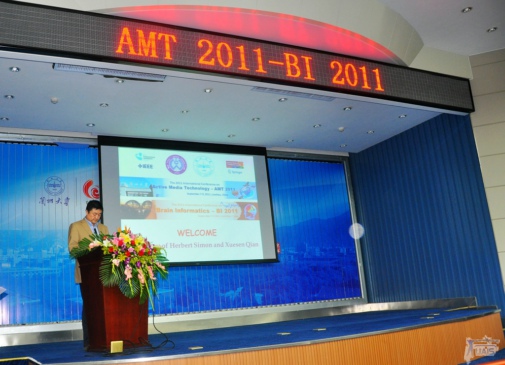2011 International Conference on Active Media Technology and Brain Informatics was held in Lanzhou University
From September 7th to 9th, 2011, the “2011 International Conference on Active Media Technology and Brain Informatics”, sponsored by the UAIS Laboratory of the academy of Information Science and Engineering, Lanzhou University, and coorganized by the Institute of Mathematics and Systems Science, Chinese Academy of Sciences, was held in Lanzhou University. Xiao Renyi, deputy director of the Second Division of the Information Science Department of the National Natural Science Foundation of China, and He Xiaodong, Vice President of the University, more than 80 experts and scholars from 18 countries and regions attended the international conference. At the invitation of Dean Hu Bin of Lanzhou University Academy of Information, Director of the State Key Laboratory of Brain and Cognitive Science, Chinese Academy of Sciences, Chen Lin, Academician of the Chinese Academy of Sciences, Director of the Center for Knowledge Science and Technology, Dalian University of Technology, and Wang Zhongtuo, Academician of the Chinese Academy of Engineering , attended the meeting as a special guest.
He Xiaodong, Vice President of Lanzhou University, expressed his warm welcome to the two academicians. He briefed the participating experts on the basic situation of the school, and hoped that our school would use the opportunity of holding this international conference to continuously enhance the cooperation and exchanges between our university and relevant universities and research institutions at home and abroad, and promote the development of relevant disciplines in our school.
Xiao Renyi, deputy director of the Second Division of the Information Science Department of the National Natural Science Foundation of China, expressed warm congratulations to the convening of this meeting. He hoped that this meeting will play a positive role in promoting talent training and international cooperation in the western region.
Chen Lin, academician of the Chinese Academy of Sciences, and Wang Zhongtuo,academician of the Chinese Academy of Engineering, respectively,entitled”The Global-first Topological Definition of Perceptual Objects, and Its Neural Correlation in Anterior Temporal Lobe” and “Study of System Intuition from Notice(cognitive) Science Founded by Xuesen Qian”s academic report.
In the report, Academician Chen Lin introduced the research background of psychology and cognitive science, and put forward the fundamental problem of “Where does the perceptual process start?” and then refines it to the scientific question of “what is the basic unit of perceptual consciousness”. He detailed the object tracking experiments and some other experiments in the case of topological changes and non-topological changes. Combined with FMRI (Functional Magnetic Resonance Imaging) technology, he demonstrated and developed in various aspects from 《Science》 in 1982. The proposed topological property perception theory of “from large-scale to local”.
In the report, Academician Wang Zhongtuo pointed out from the concept and research significance of system engineering that the system intuition is a combination of intuitive understanding and overall understanding, and is a combination of “thinking”, “seeing” and “doing”,and cognitive science is a science about “thinking.”In this field, Professor Qian Xuesen has established a more inclusive science of thinking, including abstract (logical) thinking, imaginative thinking, and creative thinking. Establishing a new type of thinking science concept advocated by Professor Qian Xuesen and integrating thinking science into system engineering will facilitate the analysis and formulation of decision-making.
Since its first annual meeting in Hong Kong, China in 2001, the AMT-BI conference has been held in Chongqing, China, Kagawa, Japan, Brisbane, Australia, Beijing, China and Toronto, Canada. More than 80 experts and scholars from more than 40 universities and research institutions in 18 countries and regions attended the conference. A total of 113 papers were received at the conference, and 8 keynote reports and 14 group discussions were held. The conference was a complete success.

